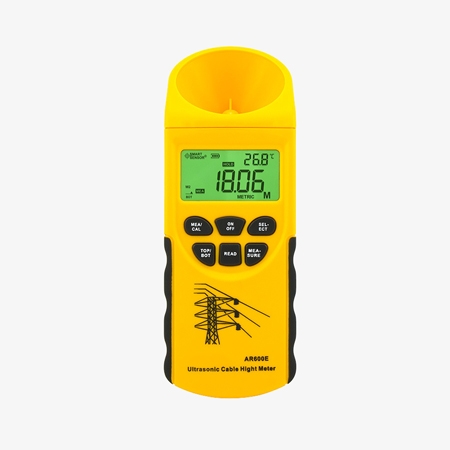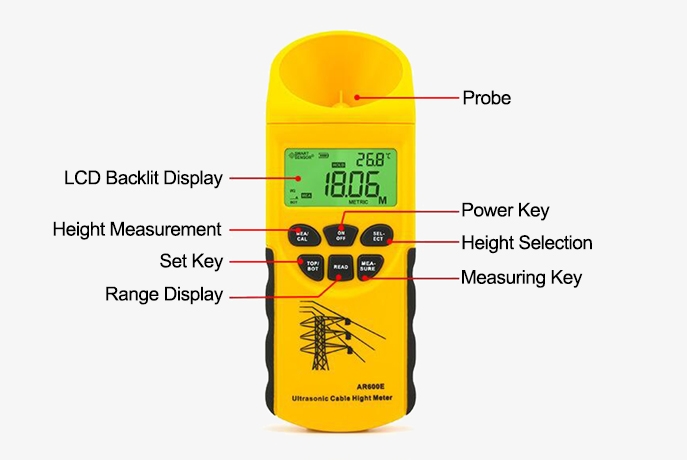The cable height meter features an extensive measurement range of 3 to 23 meters, offering high measurement accuracy for reliable results. It is designed to measure the heights of up to six cables simultaneously, making it ideal for various applications such as power line inspections and overhead cable installations.

High-Precision Measurement and Multifunctional Capability
- Electrochemical Sensor: Features stable and precise performance with rapid response.
- Simultaneous Measurement: Capable of measuring the height of six cables at once, suitable for various cable applications.
- Temperature Compensation Function: Automatically adjusts for errors caused by temperature variations within a range of -10°C to +40°C.

Enhanced Portability and Ergonomic User-Centered Design
- Portable Design: Compact and easy to carry, ensuring convenience during operation.
- Keypad Panel: Made of high-quality rubber, offering a comfortable touch and excellent durability for long-term use.
- Back Support Design: Digital ultrasonic cable length meter equipped with a rear support stand to enable stable and hassle-free measurements.
Applications
SISCO digital ultrasonic cable length meter is widely applicable for measurements across various industries and fields. It is commonly used for measuring power and communication transmission cables, electrical cables for locomotives and trolleybuses, as well as in large industrial enterprises. The device is also highly effective in power transmission and transformation cable measurements, ensuring precision and reliability. In addition, it is utilized for cable measurements at construction sites and can be employed for measuring the height and horizontal distance of trees, utility poles, and tower structures, making it an essential tool in construction, infrastructure projects, and environmental monitoring. Its versatility and accuracy make it a valuable instrument for a wide range of applications.

Power Construction Site

Cables and Trolleybuses

High-Altitude Cable Testing

Power Cable Measurement
| Model | SISCO-CL-AR600E |
| Measurement Method | Ultrasound |
| Plane Measurement Range | 3m~23m |
| Resolution | 5mm(<10m), 10mm(>10m) |
| Minimum Distance Between Cables | 150mm |
| Measurement Accuracy | 0.5%±2dgt |
| Automatic Shutdown | √ |
| LCD Backlight Display | √ |
| Ambient Temperature Measurement | √ |
| Low Battery Warning | √ |
| BOT Mode | Measure the distances of the lowest 6 cables one by one |
| TOP Mode | Measure the distances of the top 6 cables one by one |
| Power Supply | 9V Battery (NOT INCLUDING) |
| Net Weight | 205g |
Details

Dimensions (mm)

Packing List
- 1 x Cable length meter
- 1 x Cover bag
- 1 x Warranty card
- 1 x User Manual
- 1 x Packing box

Q1: What materials can a cable length meter measure?
A1: A cable length meter is primarily designed to measure the length of various types of cables and wires, including power cables, communication cables, coaxial cables, and fiber optic cables. In addition to cables, it can also measure other flexible or linear materials such as ropes, belts, and wires used in industrial and construction settings. The device works by emitting ultrasonic or laser signals that reflect off the material, allowing it to calculate the length. While cable length meters are mainly used for cables, some advanced models can also measure non-cable materials, making them versatile tools for various applications in manufacturing, telecommunications, and electrical industries.
Q2: Can a cable length meter be used for measuring cables in motion?
A2: Yes, a cable length meter can be used to measure cables in motion, especially models equipped with ultrasonic technology. These meters can quickly calculate the length of cables or wires that are moving through machinery, conveyor belts, or other industrial processes without the need for direct contact with the material. The ultrasonic waves can accurately reflect off the moving cable and return to the meter, allowing it to determine the length in real-time. This feature is particularly useful in industries where cables are continuously fed through equipment, ensuring precise measurements even during motion. However, the effectiveness of measuring moving cables can depend on the specific model and its capability to handle such dynamic conditions.
There are also specialized meter counters for high-speed applications, like those in manufacturing lines, which can handle faster counting rates and higher precision. Additionally, some models include features like reset functions, adjustable counting speeds, and the ability to measure in both forward and reverse directions, offering flexibility in various industries.
Q3: What environmental conditions affect a cable length meter?
A3: Environmental conditions such as temperature, humidity, and atmospheric pressure can significantly affect the accuracy and performance of a cable length meter. Extreme temperatures, either too high or too low, can cause measurement errors by influencing the speed of sound or light used in ultrasonic or laser-based meters. High humidity levels can lead to signal distortion, especially in ultrasonic meters, as water vapor in the air can absorb or scatter sound waves. Additionally, dust, rain, or other environmental factors can interfere with the meter’s sensors, causing inaccurate readings or damage to the device. To ensure optimal performance, it's important to use cable length meters within the recommended environmental conditions specified by the manufacturer.
Tips: how does a ultrasound cable length meter work?
An ultrasonic cable length meter operates by emitting high-frequency sound waves (ultrasonic waves) towards the cable being measured. These sound waves travel through the air until they hit the surface of the cable. When the wave encounters the cable, it reflects back toward the meter. The device then measures the time it takes for the wave to travel to the cable and return. Since the speed of sound is known, the meter uses this time to calculate the distance between the device and the cable, which is then translated into the cable's length.
This method allows for non-contact and fast measurement, making ultrasonic cable length meters ideal for use in environments where cables are difficult to access or in motion. The device is also equipped with technology to compensate for environmental factors, such as temperature and humidity, ensuring accurate results even in challenging conditions. Ultrasonic meters are highly accurate, offering precise cable length readings, and are often used in industries such as power, telecommunications, and construction, where accurate cable measurements are essential.
Thank you for buying industrial test and measurement equipment on SISCO.com, all products sold by SISCO and the partner cover a 12 months warranty, effective from the date of receiving the products.
What is covered?
SISCO is responsible for providing free spare parts, and free technical support to assist the customer to repair the defective products until the problem is solved.
What is not covered?
- Product purchased from anyone other than a SISCO store or a SISCO authorized reseller.
- Expendable parts.
- Routine cleaning or normal cosmetic and mechanical wear.
- Damage from misuse, abuse or neglect.
- Damage from use of parts other than SISCO approved.
- Damage from use outside the product’s usage or storage parameters.
- Damage from use of parts not sold by SISCO.
- Damage from modification or incorporation into other products.
- Damage from repair or replacement of warranted parts by a service provider other than a SISCO authorized service provider.
- Damage caused by the application environment not meeting the product usage requirements and the failure to perform preventive maintenance.

